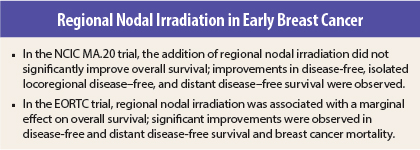Two phase III trials recently reported in The New England Journal of Medicine indicated that the addition of regional nodal irradiation was associated with no or marginal overall survival benefit but significantly improved disease-free survival in patients with early-stage breast cancer.1,2
NCIC MA.20 Trial
In the National Cancer Institute of Canada (NCIC) Clinical Trials Group MA.20 trial,1 reported by Timothy J. Whelan, BM, BCh, of McMaster University and Juravinski Cancer Centre at Hamilton Health Sciences, Ontario, Canada, and colleagues, 1,832 women with node-positive or high-risk node-negative disease treated with breast-conserving surgery and adjuvant systemic therapy were randomly assigned between March 2000 and February 2007 to undergo whole-breast irradiation with (n = 916) or without (n = 916) regional nodal irradiation, including internal mammary, supraclavicular, and axillary lymph nodes. The primary outcome was overall survival.
The nodal-irradiation and control groups were generally balanced for age, initial sentinel node biopsy, axillary nodes removed, number of positive axillary nodes, tumor size , estrogen receptor status, progesterone receptor status, adjuvant chemotherapy, adjuvant endocrine therapy, and boost irradiation.
Survival
Median follow-up was 9.5 years. At the 10-year follow-up, rates of overall survival were 82.8% in the nodal-irradiation group vs 81.8% in the control group (hazard ratio [HR] = 0.91, P = .38). Ten-year rates were 82.0% vs 77.0% for disease-free survival (HR = 0.76, P = .01), 95.2% vs 92.2% for isolated locoregional disease–free survival (HR = 0.59, P = .009), and 86.3% vs 82.4% for distant disease–free survival (HR = 0.76, P = .03).
Toxicity
Among acute adverse events, rates of grade ≥ 2 pneumonitis (1.2% vs 0.2%, P = .01) and radiation dermatitis (49% vs 40%, P < .001) were higher in the nodal-irradiation group. Among delayed events, rates of grade ≥ 2 lymphedema (8.4% vs 4.5%, P = .001), skin telangiectasia (6.9% vs 4.3%, P = .02), and subcutaneous fibrosis (4.1% vs 2.0%, P = .01) were higher in the nodal-irradiation group. There was no difference between groups in the rates of second cancers (11.0% vs 10.0%).
The investigators concluded:
Among women with node-positive or high-risk node-negative breast cancer, the addition of regional nodal irradiation to whole-breast irradiation did not improve overall survival but reduced the rate of breast-cancer recurrence.
EORTC 22922-10925 Trial
In a trial conducted by the European Organisation for Research and Treatment of Cancer (EORTC) Radiation Oncology and Breast Cancer Groups,2 reported by Philip M. Poortmans, PhD, of Radboud university medical center, Nijmegen, Netherlands, and colleagues, 4,004 women with a centrally or medially located primary tumor, irrespective of axillary involvement, or an externally located tumor with axillary involvement were randomly assigned between 1996 and 2004 to undergo whole-breast or thoracic-wall irradiation with (n = 2,002) or without (n = 2,002) regional nodal irradiation (internal mammary and medial supraclavicular nodes) after surgery. The primary endpoint was overall survival.
The nodal-irradiation and control groups were balanced for age (median, 54 years in both), surgery (mastectomy in 24% in both, breast-conserving in 76% in both), tumor size (≤ 2 cm in 60% in both), number of involved axillary nodes (0 in 44% in both, 1–3 in 43% in both), and adjuvant treatment (none in 16% and 15%, chemotherapy in 25% in both, hormonal therapy in 29% and 30%, both in 30% in both). Among patients undergoing mastectomy, 73% of the patients in both groups underwent chest-wall irradiation. Adjuvant systemic treatment was administered to 99% of patients with node-positive disease and 66% of patients with node-negative disease.
Survival
Median follow-up was 10.9 years. Rates of overall survival at 10 years were 82.3% in the nodal-irradiation group vs 80.7% in the control group (hazard ratio [HR] = 0.87, P = .06). Ten-year rates were 72.1% vs 69.1% for disease-free survival (HR = 0.89, P = .04), 78.0% vs 75.0% for distant disease–free survival (HR = 0.86, P = .02), and 12.5% vs 14.4% for breast cancer mortality (HR = 0.82, P = .02). A greater overall survival benefit appeared to be associated with nodal irradiation among patients who received both adjuvant chemotherapy and hormonal therapy (HR = 0.72, 95% confidence interval = 0.55–0.94).
Toxicity
Acute side effects of regional nodal irradiation were reported to be modest. Among long-term effects, pulmonary fibrosis occurred in 4.4% of the nodal irradiation group vs 1.7% of the control group (P < .001), cardiac fibrosis occurred in 1.2% vs 0.6% (P = .06), and cardiac disease occurred in 6.5% vs 5.6% (P = .25). Second cancers were observed in 9.5% vs 11.1%.
The investigators concluded: “In patients with early-stage breast cancer, irradiation of the regional nodes had a marginal effect on overall survival. Disease-free survival and distant disease–free survival were improved, and breast-cancer mortality was reduced.” ■
Disclosure: The NCIC MA.20 trial was funded by the Canadian Cancer Society Research Institute and others. The EORTC trial was funded by Fonds Cancer. For full disclosures of the study authors, visit www.nejm.org.
References
1. Whelan TJ, Olivotto IA, Parulekar WR, et al: Regional nodal irradiation in early-stage breast cancer. N Engl J Med 373:307-316, 2015.
2. Poortmans PM, Collette S, Kirkove C, et al: Internal mammary and medial supraclavicular irradiation in breast cancer. N Engl J Med 373:317-327, 2015.




